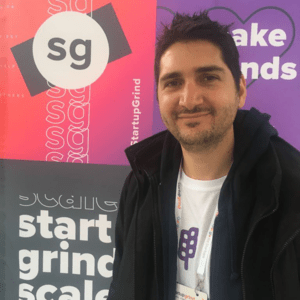I’m a computer engineer transformed into a ⚙️ passionate No Coder ⚙️. Reach out if you want to get introduced or learn more about the No Code world!
It’s not so complicated: Product-Led Growth for startups
Many startups still don’t get Product-Led Growth.
They’re investing too early.
The question is simple: do you have Product-Market Fit?
If you have Product Market Fit and you know what success means, it’s time to look for opportunities in your model: is product-led right for you?
Join Diego von Söhsten to learn more.
You’ll hear about:
- Product-Led Growth for startups vs more mature companies
- why Product-Led not being a replacement for sales and marketing
- great onboarding experiences, “aha” moments and points of friction
- what product-led acquisition means and how it relates to monetization
Tools mentioned:
- Heap, Amplitude and Looker for analytics-focused actions
- Pendo and Appcues for directing people to value
- Hotjar and Fullstory, to see what your users do and fight churn
And all of this in just 15 minutes!
Transcript
Diego von Söhsten: Hi. My name is Diego and I’m a Director of Product at Vidyard. I’ve been working with product management for over seven years. And I’ve been overall in tech for over 13. Very passionate about growth in special product like Bureau strategies, and I’m happy to be here talking more about the topic today.
Spyros Tsoukalas: Diego, welcome to the GrowthMentor Podcast. Having read some of your business online. I’m excited to be talking with you about product led growth. So let’s go straight to the point. Could you tell us something we don’t know about product lead growth?
Diego von Söhsten: Yeah, let’s try. Let’s try. So first of all, what I see is product lead growth is a strategy where a product is doing the work to acquire, retain and monetize users. So you think about sales lead being very common marketing lead becoming more popular I think 50 years ago, and product lead became a trend more recently. Starting with B2C and B2B. That’s great to the users. So like you and I, we can do more by ourselves. When we are interacting with a product, we don’t need to raise your hand to work with a rep on the other side. Now, my heartache is that I believe that many companies that claim to be product flat, they actually skipping steps. So more common deny people believe that creating a try for free or create a free account option means that you’ve become credit clad. And first of all, that’s just a tiny piece of what PLG means. But more importantly, starting with acquisition, accelerating acquisition without having a deep understanding of the problems that your product is solving. Who it’s solving for, in what retention means. Not figuring that out first means that you might be skipping steps and you won’t get the most out of PLG.
Spyros Tsoukalas: I like this differentiation that they see between growth in product lead growth and the rest of the steps that you described. Could you elaborate a little more around the topic of product lead growth for startups. Which are just launching or have launched like for a few months or so versus more mature companies?
Diego von Söhsten: For sure. So when I think about PLG, I think is a strategy. It’s the same, it’s the same principles, no matter the company size. When you think about startups, especially in early stage, there is a change, though, then you may see me pursuing product market fit. And that idea that you’re solving a valid problem in the market, and that your product may have the capabilities to do so. But until you reach that state, I would question Is it really worth investing the time in building a growth engine on your product? If you don’t have the validation that your product is solving a valid problem. So I’ve seen many early stage startups way before reaching product market fit, creating building referral programmes. Self service options sophisticated in product onboarding, but then 95% of their users will never come back. So that whole idea that you know, chief product market fit first, do things that don’t scale, do what it takes to reach that state first. And then take a step back and think about what PLG means to you, and how we can boost your startups ability to acquire, retain and convert more users.
Spyros Tsoukalas: I think that the what you just mentioned is one of the mistakes that startups might have been doing during their efforts. Could you share a few more mistakes that startups might be doing around product led growth?
Diego von Söhsten: Yeah, something that I see. More common deny is that the idea sometimes people have that product lead growth is a replacement for sales and marketing. I don’t believe that’s the case. So when you look at other players in the market, very successful products started with a 100%. product like motion for acquisition, retention, monetization in layer did other motions, the reach product market fit, they double down on product lead, and then the broad sales lead and marketing like motions afterwards. Zapier is a good example. So the first they believe found a problem to solve and they saw that very well. They created self service options. And more recently, they formed a sales team to be able to better serve enterprise accounts. So they felt that they were missing some opportunities where the product couldn’t do all the work in a specific set. I mean sort of verticals. And then having humans play a more consultative role seems to be working well for them. So marketing and sales can always supplement very well a product like motion. And that’s just one of the examples I have.
Spyros Tsoukalas: Great. I like how you referred to Zapier, which is quite popular, and I kind of felt what you meant, like during this example. So is there any approach or framework that you personally use around product lead growth that we could split into a few steps are described in a few words?
Diego von Söhsten: For sure. So it will start with the question, have you reached product market fit? And there are many ways to answer that question. We even had a blog post about that recently. So if you have reached that state with your starter, you may want to validate your understanding of the problems you’re solving, who you’re solving for, and how you can measure that. So I’ve seen many products, using that idea that, hey, we imagined we attracting active users. But activity doesn’t mean much in terms of the value that people are getting out of your product. So you know, you should identify what problem you’re solving, how often you do that, and what sort of action or behaviour happens in or out of your product that captures that value. Once you have that mapping in place, you will be able to identify what successful onboarding looks like. So hey, I know how I should retain my users. I know what problem I’m solving. I got signals from the market. That’d be a dream that well. Now let’s take a step back before you reach that state. What is a successful onboarding experience? When does a product click to your target user? When do they have that aha moment, where they perceive how your solution can help them solve a problem. And then looking at you know, friction points and opportunities impacting your product’s ability to retain, or in other words, onboarding, engage users, is super, super important. And I talked a lot about rotation, which includes the onboarding piece, but there are two other pieces in that PLG. bucket. So there’s one about acquisition. And there’s another one about manifestation. For acquisition, you can ask yourself the question, how do you acquire customers, and for every user that you bring how many users do the invite to your product? The whole idea of virality the whole idea of sharing content, and maybe sharing your product with someone else? So for a long time, we thought about acquisition as funnels, you bring the user, you’re done. But you know, there’s a more efficient way of thinking about acquisition in terms of loops. For every user you bring, can they bring someone else? That’s one way to do product lead acquisition? And for monetization? How do you make money with your product? And then unpacking your model? So what are you charging for? What is the value that you’re offering? When do people pay for that? And how do you scale it, then you might be thinking about repackaging your product or creating self service options for people to purchase, you know, an add on or to agree to not a package using your product. But for both acquisition and monetization, and as well as retention, you should only get there once you reached product market fit, in my opinion.
Spyros Tsoukalas: Thanks for sharing your methodology. And like it seems like this has been developed along the years you have been working around the topic. So going a little deeper. How do the following relate in your work life or in the field for you like growth product management, and retention and engagement? Like you already mentioned some of those terms as part of your previous question, I’m sure. Well, could you elaborate a little more on these topics?
Diego von Söhsten: 100%. So I think that PLG is something that brings many functions together, in one of those functions would be product management. And for a long, long time, we believe that product managers can be generalists. And do a little bit of growth, wild beauty, new features, new capabilities, doing research in the market. And there’s this whole movement now about specialisation. The idea that you can have a growth product manager as part of your drove strategy in your business. So growth product managers, they basically they are looking at those levers acquisition, retention, monetization, and they’re looking for opportunities to drive more growth. for the business. So, I personally believe that growth is a subset of what product management looks like. Developers sales, reps marketing, they all have those areas of focus array. And product managers are always treated as one big set of responsibilities. There’s one role. And I believe in specialisation, I believe that the tools for driving engagement acquisition, they’re very different than the skill set and the tools that you may need to build on your feature as a traditional product manager. So that’s been my area of expertise in the in the recent years, really developing those skills in that growth area. And I also believe that PMS will work with that their Creator, many experiments, I didn’t find friction points, is slowing down their engine, and optimising that looking for opportunities to you know, remove those constraints, and put your product in a place where you can acquire, engage and convert more users. And to wrap that up, I also believe that just thinking about a growth product manager, as someone who runs experiments, is a very simplified explanation of that role. So I believe that, you know, we should have a portfolio of backs and investments, the high risk items that we want to, you know, maybe pass, but also the big things that we need to do in order to enable growth for our product in the long term.
Spyros Tsoukalas: Thanks for the very detailed answer. The last question for us today. What tools do you enjoy using nowadays? And maybe what resources are you following?
Diego von Söhsten: Yeah, that’s a great question. So with having, having that strategy in place, then I like to look for tools to get the job done. And then I really liked the idea of doing qualitative research. When it comes to understanding the problems you’re solving for the jobs to be done. There are great books out there about creating jobs to be done maps, and running interviews, using a framework. So that you can map out your use cases, which is a foundation of growth, you need to have that in place. Once you have that. And once you know what retention looks like then you can use software, right? So tools like Data Studio, Heap, Amplitude, Looker, they can all allow you to understand how people are engaging with your product, as well as validate and identify opportunities to improve those metrics. And you really want to drive their products such as Pindo and at Hughes, where you can create in product tools, and you know, you can drag people to value. People using your product, you can add prompts, you can add onboarding tours. And then to learn about why people are dropping off and not necessarily completing an action. There’s another category of tools. So I think you know, about Hotjar, Full Story, they allow you to watch people engaging with your tool. And then you’re always able to do that continuous discovery, right, you can see people engaging with your product, and maybe they get stuck along the way. And having those recordings is super, super helpful. For acquisition, the tools that work for marketing will work for you on the product side, understanding where your users are coming from. And yeah, that’s, that’s a little bit of it.
Spyros Tsoukalas: Diego, thank you very much for your time today and all the interesting insights that you shared with us. I hope that people listening to this episode will enjoy it as much as I did.
Diego von Söhsten: Thank you so much for having me here. That was a great chat.
In this episode


I’m a developer-turned-product leader. With 13+ years in tech, I’ve led growth product management in companies such as Vendasta and Vidyard. I’m an advocate of product-led growth, being in charge of acquisition, activation, retention, and monetization initiatives. Looking forward to chatting!
Join the community
Enjoy the peace of mind that advice is always only one Zoom call away.


